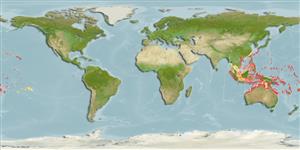>
Eupercaria/misc (Various families in series Eupercaria) >
Scaridae (Parrotfishes) > Scarinae
Etymology: Hipposcarus: Greek, ippos = horse + Latin, scarus = a fish cited by ancient writers; 1601 (Ref. 45335).
More on author: Valenciennes.
Environment: milieu / climate zone / depth range / distribution range
Ecologie
marien rifbewoner; diepte 0 - 40 m (Ref. 37816). Tropical; 30°N - 24°S, 95°E - 141°W
Pacific Ocean: Cocos-Keeling Islands and Rowley Shoals in the eastern Indian Ocean to the Line and Tuamoto islands, north to the Ryukyu Islands, south to the Great Barrier Reef and New Caledonia. Replaced by Hipposcarus harid in the Indian Ocean.
Grootte / Gewicht / Leeftijd
Maturity: Lm ? range ? - ? cm
Max length : 60.0 cm TL mannelijk / geslacht onbekend; (Ref. 9710); common length : 48.0 cm SL mannelijk / geslacht onbekend; (Ref. 37816)
Dorsale stekels (totaal): 9; Dorsale zachte stralen (totaal): 10; Anale stekels 3; Anale zachte stralen: 9. Small juveniles are light brownish with a broad longitudinal orange band; the primary phase is a whitish brown to light gray with a yellowish tail; the terminal phase is light blue and green (Ref. 1602, 48636). Adults best recognized by the shape of the head (Ref. 48636).
Inhabits turbid lagoons more than outer reef areas. Usually seen in aggregations; females usually in small groups (Ref. 48636). Feeds on benthic algae (Ref. 89972). Minimum depth reported taken from Ref. 128797. Large adults may occur to depths of at least 40 m.
Levenscyclus en paargedrag
Maturiteit | Voortplanting | Paaien | Eieren | Fecunditeit | Larven
Oviparous, distinct pairing during breeding (Ref. 205).
Randall, J.E., G.R. Allen and R.C. Steene, 1990. Fishes of the Great Barrier Reef and Coral Sea. University of Hawaii Press, Honolulu, Hawaii. 506 p. (Ref. 2334)
Status op de Rode Lijst van het IUCN (Ref. 130435)
Gevaar voor de mens
Reports of ciguatera poisoning (Ref. 130160)
Gebruik door de mens
Visserij: commercieel
Meer informatie
ReferentiesAquacultuurAquacultuurprofielKweeklijnenGeneticaElectrophoresesErfelijkheidZiektesVerwerkingNutrientsMassaconversie
Tools
Speciale rapporten
Download XML
Internetbronnen
Estimates based on models
Preferred temperature (Ref.
123201): 24.8 - 28.9, mean 27.7 °C (based on 518 cells).
Fylogenetische diversiteitsindex (Ref.
82804): PD
50 = 0.7500 [Uniqueness, from 0.5 = low to 2.0 = high].
Bayesian length-weight: a=0.01175 (0.00722 - 0.01913), b=3.02 (2.88 - 3.16), in cm total length, based on LWR estimates for this species & (Sub)family-body (Ref.
93245).
Trofisch niveau (Ref.
69278): 2.0 ±0.1 se; based on diet studies.
Weerstandsvermogen (Ref.
120179): Hoog, minimale populatieverdubbelingstijd minder dan 15 maanden (K=0.5).
Fishing Vulnerability (Ref.
59153): Low to moderate vulnerability (27 of 100).
Nutrients (Ref.
124155): Calcium = 43.9 [25.2, 80.3] mg/100g; Iron = 0.713 [0.385, 1.197] mg/100g; Protein = 18.8 [16.7, 20.6] %; Omega3 = 0.0999 [, ] g/100g; Selenium = 42.2 [24.0, 80.9] μg/100g; VitaminA = 30.4 [9.0, 104.6] μg/100g; Zinc = 1.44 [0.99, 2.25] mg/100g (wet weight);
